flight engineer

 I have been studying a lot lately about World War II. It is my “favorite” war…if one can have a favorite war. My dad, Allen Spencer was a Staff Sergeant in World War II. He served as flight engineer and top turret gunner on a B-17G, the flying fortress. The more I study World War II, the more I realize just how dangerous was…no matter what branch of the service a soldier was in. Dad’s family was one that didn’t have to suffer the loss of their soldier, because my dad came home after the war. He was the only one in his family that saw action in World War II, other than his half-brother, Norman Spencer. Dad’s older brother, Bill tried to serve, but due to flat feet and a hernia, he was turned down. My Uncle Bill was devastated by the rejection. My dad was his little brother, and he had always felt a need to protect him, not because Dad was accident prone or anything, but because he was his little brother. Now, he was going to have to let Dad go without the “backup” that Uncle Bill had hoped to provide. That was one of the hardest things my Uncle Bill ever had to do. So, Dad went with angel backup instead…and his mother’s prayers.
I have been studying a lot lately about World War II. It is my “favorite” war…if one can have a favorite war. My dad, Allen Spencer was a Staff Sergeant in World War II. He served as flight engineer and top turret gunner on a B-17G, the flying fortress. The more I study World War II, the more I realize just how dangerous was…no matter what branch of the service a soldier was in. Dad’s family was one that didn’t have to suffer the loss of their soldier, because my dad came home after the war. He was the only one in his family that saw action in World War II, other than his half-brother, Norman Spencer. Dad’s older brother, Bill tried to serve, but due to flat feet and a hernia, he was turned down. My Uncle Bill was devastated by the rejection. My dad was his little brother, and he had always felt a need to protect him, not because Dad was accident prone or anything, but because he was his little brother. Now, he was going to have to let Dad go without the “backup” that Uncle Bill had hoped to provide. That was one of the hardest things my Uncle Bill ever had to do. So, Dad went with angel backup instead…and his mother’s prayers.
Dad served and returned home to his family, and because he did, my sisters and I, and our whole family exists. 
 Dad, like many of the soldiers in that generation, never spoke of his time in the service during World War II, and all we knew was what little we heard from his family, and a couple of newspaper articles. Knowing my dad as we did, those years were his duty, but never his desire. Dad was a gentle man, and the idea of killing must have weighed heavily on him. Nevertheless, he knew it was his duty, and he would never have shirked his duty. There were a number of heroic times in Dad’s time in the service. He actually saved his crew, when he cranked down the landing gear just in time to hit the runway. It must have been damaged by the anti-aircraft flak, because it wouldn’t come down. There were other times that his actions saved his crew, such as the enemy planes that he shot down. They were a good team. They were all heroes…every single one.
Dad, like many of the soldiers in that generation, never spoke of his time in the service during World War II, and all we knew was what little we heard from his family, and a couple of newspaper articles. Knowing my dad as we did, those years were his duty, but never his desire. Dad was a gentle man, and the idea of killing must have weighed heavily on him. Nevertheless, he knew it was his duty, and he would never have shirked his duty. There were a number of heroic times in Dad’s time in the service. He actually saved his crew, when he cranked down the landing gear just in time to hit the runway. It must have been damaged by the anti-aircraft flak, because it wouldn’t come down. There were other times that his actions saved his crew, such as the enemy planes that he shot down. They were a good team. They were all heroes…every single one.
While my dad was a hero during World War II, I will always consider his most important accomplishment, his family. Without my dad’s safe return from the war, we would not exist. He met my mom, Collene Byer Spencer when she was still a schoolgirl, but even then, they knew it was that forever love. They married in 1953, an 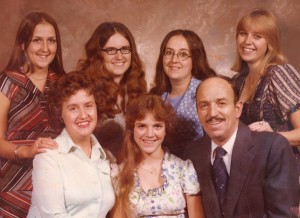
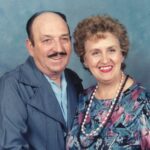 became the parents of five daughters, Cheryl, Masterson, Caryn Schulenberg (me), Caryl Reed, Alena Stevens, and Allyn Hadlock. They went on to have grandchildren and great grandchildren…all of whom owe their lives to the fact that dad came home from war. For that I praise God, and I give Him all the glory. Today would have been my dad’s 99th birthday. Happy birthday in Heaven, Dad. We love and miss you very much and look forward to seeing you again when we get to Heaven.
became the parents of five daughters, Cheryl, Masterson, Caryn Schulenberg (me), Caryl Reed, Alena Stevens, and Allyn Hadlock. They went on to have grandchildren and great grandchildren…all of whom owe their lives to the fact that dad came home from war. For that I praise God, and I give Him all the glory. Today would have been my dad’s 99th birthday. Happy birthday in Heaven, Dad. We love and miss you very much and look forward to seeing you again when we get to Heaven.
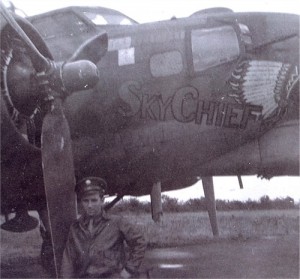
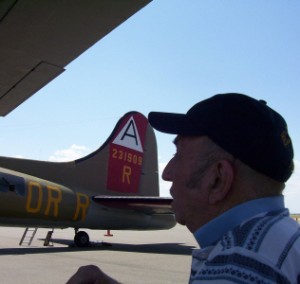 For most World War II history buffs, like me, there is only one bomber worth taking about…the B-17 Bomber. I’m sure there have been many bombers since, but the B-17 will always stand out in my mind. I’m sure that is partly because my dad spent his entire time in World War II as the Top Turret Gunner and Flight Engineer on a B-17G Bomber, stationed at Great Ashfield in Suffolk, England, about nine miles from Bury Saint Edmonds.
For most World War II history buffs, like me, there is only one bomber worth taking about…the B-17 Bomber. I’m sure there have been many bombers since, but the B-17 will always stand out in my mind. I’m sure that is partly because my dad spent his entire time in World War II as the Top Turret Gunner and Flight Engineer on a B-17G Bomber, stationed at Great Ashfield in Suffolk, England, about nine miles from Bury Saint Edmonds.
Dad was so proud of the beautiful, brand-new B-17G Bomber. The thing he might have known, but that I certainly didn’t, is that when those shiny brand-new B-17 Bombers came out and were sent out to battle, they were already considered to be outdated. Of course, outdated, does not mean they couldn’t be used, because they not only could be used, but they were very effective. I suppose that the fact that they were outdated could have meant that they were slower, more awkward, or less accurate, but during World War II, they were very effective, and the people they protected were extremely grateful for their prominent presence on the 
 battlefield. Those planes were almost indestructible…short of losing a wing anyway.
battlefield. Those planes were almost indestructible…short of losing a wing anyway.
While the reality is that far more Consolidated B-24 Liberators were produced and were used more extensively than B-17s, both as bombers and in other roles. Nevertheless, the B-17 had a following. It was beloved by so many people…even though it was predominantly used in the Eighth Air Force. Really, it is most likely because the historians, who were mainly focusing on the war in Europe, and who have devoted so much coverage to the Boeing B-17 Flying Fortress, that the B-17 is often thought of as the only American bomber of the war, or at least until the much larger B-29 Superfortress was introduced by Boeing. Still, the B-29 Superfortress, in the minds of many people anyway, couldn’t hold a candle to the B-17 if the minds of the people. In fact, while thousands of Douglas A-20s, North American B-25s, and Martin B-26s, as well as excellent British bombers 
 such as the Lancaster and Wellington, served in all theaters of war, it was The Fort, as it has lovingly been called, that has come to symbolize the air war perhaps more than any other bomber…of any era. For me, the B-17 will always be the most awesome, and greatest bomber ever built. When one flies overhead, I recognize the sound. I can pick one out while it is flying, even if it is too far away to hear the engines. If I had to pick an airplane that will always be iconic, the B-17 is it, and always will be.
such as the Lancaster and Wellington, served in all theaters of war, it was The Fort, as it has lovingly been called, that has come to symbolize the air war perhaps more than any other bomber…of any era. For me, the B-17 will always be the most awesome, and greatest bomber ever built. When one flies overhead, I recognize the sound. I can pick one out while it is flying, even if it is too far away to hear the engines. If I had to pick an airplane that will always be iconic, the B-17 is it, and always will be.
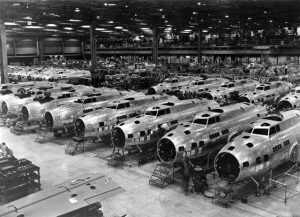
 In World War II, my dad, Allen Spencer was the Flight Engineer and top turret gunner on a B-17. The B-17 was an amazing plane. Strategic bombing missions actually began at the tail end of World War I, And the big world powers knew that they needed to develop bomber fleets that could handle this new kind of bombing mission, because if they did not, they would be vulnerable to the evil nations who did develop such bombers. During the month of August 1934, in anticipation of rising tensions in the Pacific, the US Army Air Corps proposed a new multi-engine bomber that would replace the outdated Martin B-10. They put out the challenge and Boeing decided to get into the competition. The plan for this bomber was to provide reinforcement to bases in Hawaii, Alaska, and Panama.
In World War II, my dad, Allen Spencer was the Flight Engineer and top turret gunner on a B-17. The B-17 was an amazing plane. Strategic bombing missions actually began at the tail end of World War I, And the big world powers knew that they needed to develop bomber fleets that could handle this new kind of bombing mission, because if they did not, they would be vulnerable to the evil nations who did develop such bombers. During the month of August 1934, in anticipation of rising tensions in the Pacific, the US Army Air Corps proposed a new multi-engine bomber that would replace the outdated Martin B-10. They put out the challenge and Boeing decided to get into the competition. The plan for this bomber was to provide reinforcement to bases in Hawaii, Alaska, and Panama.
Enter the B-17 Flying Fortress. Boeing competed against both Martin and Douglas for the contract to build 200 units of such a bomber, but failed to deliver, as the first B-17 Flying Fortress crashed. Nevertheless, the Air Corps loved the design so much that they ordered 13 units for further evaluation and analysis. After a string of tests, it was introduced in 1938. The B-17 was now the prime bomber for all kinds of bombing raids. The prototype B-17 Bomber was built at the company’s own expense and was a fusion of the features of Boeing XB-15 and Boeing 247 Transport Aircraft. Initially, it could carry a payload of 4850 pounds along with 5x .30-inch machine guns. The 4x Hornet Radial Engines could produce 750 HP at 2100 meters. It was a tremendous machine. A reporter from the Seattle Times would nickname it The Flying Fortress…a name that stuck, even if he didn’t know how very accurate he was.
As World War II heated up, the attack on Pearl Harbor drew the United States into it, and the B-17 Flying 
 Fortress became a staple, used in every single World War II combat zone and by the time production ended in 1945. Boeing along with Douglas and Vega had built 12,731 bombers. When the US 8th Airforce arrived in England in 1942, their sole mission was to destroy Germany’s ability to wage war. They would use any means necessary, from carpet bombing to precision bombing. On August 17th, 1942, eighteen B-17s launched a bombing raid over Nazi-held territory in Europe, hitting railway networks and strategic points. The Luftwaffe was unprepared and didn’t know how to best attack the new planes, but it didn’t take long to improve their tactics. The B-17s suffered losses too. On September 6th, 1943, 400 bombers were sent out to attack a ball-bearing plant, 45 didn’t return. October 4th, 60 out of 291 B-17s sent to the same location were lost. January 11th, 1944, 600 B-17s were sent to various industries. Bad weather kept all but 238 of them on base. Still, 60 were lost. These losses were quite costly when you consider that a single B-17 Flying Fortress would cost $238,329 in 1945. The Luftwaffe quickly perfected their attacks on the B-17 Flying Fortress. Head on proved more fruitful and therefore the Americans developed the term “Bandits at 12 O’clock High” for oncoming Luftwaffe fighters.
Fortress became a staple, used in every single World War II combat zone and by the time production ended in 1945. Boeing along with Douglas and Vega had built 12,731 bombers. When the US 8th Airforce arrived in England in 1942, their sole mission was to destroy Germany’s ability to wage war. They would use any means necessary, from carpet bombing to precision bombing. On August 17th, 1942, eighteen B-17s launched a bombing raid over Nazi-held territory in Europe, hitting railway networks and strategic points. The Luftwaffe was unprepared and didn’t know how to best attack the new planes, but it didn’t take long to improve their tactics. The B-17s suffered losses too. On September 6th, 1943, 400 bombers were sent out to attack a ball-bearing plant, 45 didn’t return. October 4th, 60 out of 291 B-17s sent to the same location were lost. January 11th, 1944, 600 B-17s were sent to various industries. Bad weather kept all but 238 of them on base. Still, 60 were lost. These losses were quite costly when you consider that a single B-17 Flying Fortress would cost $238,329 in 1945. The Luftwaffe quickly perfected their attacks on the B-17 Flying Fortress. Head on proved more fruitful and therefore the Americans developed the term “Bandits at 12 O’clock High” for oncoming Luftwaffe fighters.
Various models of the B-17 Flying Fortress were produced, but the B-17G was the one that was most liked. Almost 9000 B-17Gs were produced, the most of any of the models, because of their superior specs. A B-17G weighed 65,000 pounds and could cruise at a speed of 150 miles per hour, peaking at 287 miles per hour. It could attain a service ceiling of 35,600 feet, and carry a 9600 pounds payload. The four Wright R-1820 Cyclone engines could produce 1200 horse power each! It was one rugged machine. One particular B-17 Bomber 
 survived a bombing mission over Cologne, Germany, and flew back to safety with 180 flak holes and only 2 out of 4 engines in operation. The veteran never forgot, and 75 years later wrote a thank you letter to Boeing. He was thankful to be alive. My dad always felt that way too. Any amount of damage that happens to a plane can mean the difference between crashing and making it home. The B-17 was truly a flying fortress, and on of the best planes to be in. The chances of coming home were better than most.
survived a bombing mission over Cologne, Germany, and flew back to safety with 180 flak holes and only 2 out of 4 engines in operation. The veteran never forgot, and 75 years later wrote a thank you letter to Boeing. He was thankful to be alive. My dad always felt that way too. Any amount of damage that happens to a plane can mean the difference between crashing and making it home. The B-17 was truly a flying fortress, and on of the best planes to be in. The chances of coming home were better than most.
 B-17 crews were a tight group. Mostly these crews flew with the same crew on missions, but sometimes, someone was sick, went home, or was killed, and crews changed. For that reason, it was vital that everyone know their responsibilities. We shouldn’t write about the B-17 as a bomber without writing about the crew. In reality, the crew and their Fortress worked much like one unit. I think the crew came to love the fortress that kept them safe.
B-17 crews were a tight group. Mostly these crews flew with the same crew on missions, but sometimes, someone was sick, went home, or was killed, and crews changed. For that reason, it was vital that everyone know their responsibilities. We shouldn’t write about the B-17 as a bomber without writing about the crew. In reality, the crew and their Fortress worked much like one unit. I think the crew came to love the fortress that kept them safe.
In the cockpit, you would find the standard, pilot and co-pilot. The pilot was the commander of the crew. He was in command of the B-17, but he was also responsible for all aspects of crew training, discipline, safety and efficiency at all times, but he was more than the commander, he was also one of the crew, he wasn’t a gunner, but it was his job to bring these men home. The co-pilot was the executive officer. He must be as familiar as the pilot with all aspects of flying the B-17, ready to take over both as pilot and commander, if necessary. The B-17 required a flight crew of two to fly the plane, much like modern day jets. The co-pilot operated the instruments on the right and instruments on the left were run by the pilot. Nevertheless, in an emergency, one could fly the plane.
The navigator had the job of making sure that the plane made it to the target, and back home again. He used one or more ways of navigating: dead reckoning; using charts and visual references; pilotage, using charts along with time, distance, and speed calculations; use of radio navigation aides; and using the sun observations or at night using stars and planets. As the B-17 gets close to the target, the bombardier takes over command of the plane (including flying) as they approached the bomb target. Then, when they arrived at the target he released the bombs. Accurate bombing was crucial and that was the bombardier’s responsibility. If he wasn’t accurate, they could hit a school, a neighborhood, or other civilian area. Later on in WW II, the navigator and bombardier positions were combined into one position done by one man.
The radio operator’s job was communications, working the radios, and keeping the radios in good working order. There was a lot of radio equipment in the B-17 that allowed for both communications and navigation. He maintained a log and was often the photographer of the crew. A good radio operator knew his equipment inside out. But the radio operator was also a trained gunner. The flight engineer was one of the most important people on the plane. He knew all the equipment on the B-17 better than the pilot or any other crew member from the engines to the radio equipment to the armament to the engines to the electrical system and everything else. Many flight engineers served as maintenance crew chiefs before moving to the position of a B-17 flight engineer. The flight engineer was the final person to advise the pilot of the airworthiness of the plane before each mission. A wise pilot listened. The flight engineer doubles as top turret gunner.
 A typical crew had four gunners, sometimes less. In a configuration of four gunners there were two waist gunners (right and left), a tail gunner, and a ball turret gunner. The two waist gunners station was in the middle of the plane. As the name implies, the tail gunner’s position was in the tail and the ball turret gunner (a small man) position was in a turret underneath the B-17. Each gunner was responsible for their own armament and ensuring that their guns were in working order. Their whole job was to keep the enemy planes and enemy fire off of the B-17. So close was the relationship that these 10 men shared, that many would go on to remain friends for life, and even name their children after their respected crew mates.
A typical crew had four gunners, sometimes less. In a configuration of four gunners there were two waist gunners (right and left), a tail gunner, and a ball turret gunner. The two waist gunners station was in the middle of the plane. As the name implies, the tail gunner’s position was in the tail and the ball turret gunner (a small man) position was in a turret underneath the B-17. Each gunner was responsible for their own armament and ensuring that their guns were in working order. Their whole job was to keep the enemy planes and enemy fire off of the B-17. So close was the relationship that these 10 men shared, that many would go on to remain friends for life, and even name their children after their respected crew mates.
 In 1990, when the remake of the movie, Memphis Belle came out, I watched it with intrigue, knowing that my Dad, Allen Spencer had been a top turret gunner and flight engineer on a B-17G Bomber in the 8th Air Force stationed in Great Ashfield, Suffolk, England. The Memphis Belle, a Boeing-built B-17F-10-BO, USAAC Serial No. 41-24485, was added to the USAAF inventory on July 15, 1942, and delivered in September 1942 to the 91st Bombardment Group at Dow Field, Bangor, Maine. She deployed to Prestwick, Scotland, on September 30, 1942, moving to a temporary base at RAF Kimbolton on October 1, 1942, and then finally to her permanent base at Bassingbourn, England, on October 14, 1942. Each side of the fuselage bore the unit identification markings of the 324th Bomb Squadron (Heavy). My dad was a part of the 385th Bomb Squadron (Heavy). Dad didn’t arrive in England until early April of 1944. His letter from April 14, 1944 tells his family that he had arrived and couldn’t tell them where he was for security reasons, except to say that he was somewhere in England.
In 1990, when the remake of the movie, Memphis Belle came out, I watched it with intrigue, knowing that my Dad, Allen Spencer had been a top turret gunner and flight engineer on a B-17G Bomber in the 8th Air Force stationed in Great Ashfield, Suffolk, England. The Memphis Belle, a Boeing-built B-17F-10-BO, USAAC Serial No. 41-24485, was added to the USAAF inventory on July 15, 1942, and delivered in September 1942 to the 91st Bombardment Group at Dow Field, Bangor, Maine. She deployed to Prestwick, Scotland, on September 30, 1942, moving to a temporary base at RAF Kimbolton on October 1, 1942, and then finally to her permanent base at Bassingbourn, England, on October 14, 1942. Each side of the fuselage bore the unit identification markings of the 324th Bomb Squadron (Heavy). My dad was a part of the 385th Bomb Squadron (Heavy). Dad didn’t arrive in England until early April of 1944. His letter from April 14, 1944 tells his family that he had arrived and couldn’t tell them where he was for security reasons, except to say that he was somewhere in England.
At the time I watched the remake of the original 1943 documentary film put out by the War Department, I assumed that while the movie said it was based on a true story, there was probably a lot of Hollywood hype to  the movie. So, when I read my dad’s letter to his mother, my grandmother, Anna Schumacher Spencer, I was surprised that my dad mentioned it and said she should go see it. From my experience with the movie, I don’t think it would be a film I’d want to watch while my child was still on active duty and fighting from one of those planes. Both the original version and the remake were real enough to either show or tell of events involving the B-17 Bombers in combat situations, and the inevitable shooting down of the planes by the enemy.
the movie. So, when I read my dad’s letter to his mother, my grandmother, Anna Schumacher Spencer, I was surprised that my dad mentioned it and said she should go see it. From my experience with the movie, I don’t think it would be a film I’d want to watch while my child was still on active duty and fighting from one of those planes. Both the original version and the remake were real enough to either show or tell of events involving the B-17 Bombers in combat situations, and the inevitable shooting down of the planes by the enemy.
Of course, the point was to let people know that The Memphis Belle, a B-17 Bomber had become the first plane to accomplish 25 missions without being shot down. It was designed to be a celebration of that accomplishment. And so it was, but it also proved the stark reality that many other B-17 Bombers had been shot down, and in all reality would continue to be shot down. While the accomplishment of The Memphis Belle is nothing to take lightly, I think it would still be hard to think about all those men lost or imprisoned during that war…especially if I was the mother of an airman. In some ways, it surprised me that my dad would even ask his mom to so see the movie. He was always so protective of her. I suppose that in time, you get used to the events of war, especially when you are in the thick of it day after day, and maybe he thought it would give her hope too.

Nevertheless, it seemed rather strange to me that Dad had talked of this movie with his mother. I know that the Memphis Belle was a star, just because they had made it through without being shot down. They were the first, and to those at home trying to support the war effort, that was a moral booster. That made it important to do the movie and to have the Memphis Belle and her crew do tours back in the states. People needed to see the success of the air war. They needed hope that their loved ones would return. I suppose that was what my dad was thinking when he told his mother that she should go see the movie. I don’t know for sure if she did or didn’t, but in the end my dad came home, and that is all that mattered to my grandmother and to me.
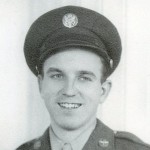
 Most of the time, when I think about the faces from my parents’ past, I think of ancestors, or school friends, or maybe even old flames. All of those people bring questions to mind, but most of them can be answered, and the relationship laid to rest, at least in the case of old friends or old flames, but some faces continue to run through my mind again and again. Such is the case with the men who served in the Army Air Force with my Dad at Great Ashfield Army Air Base, which is just North of Ipswich in Suffolk, England. I know these men were Dad’s good friends, because they were important enough to him to take their pictures to preserve their memory for the rest of his life, but for whatever reason, their names were not put on the pictures, so I don’t know who they were.
Most of the time, when I think about the faces from my parents’ past, I think of ancestors, or school friends, or maybe even old flames. All of those people bring questions to mind, but most of them can be answered, and the relationship laid to rest, at least in the case of old friends or old flames, but some faces continue to run through my mind again and again. Such is the case with the men who served in the Army Air Force with my Dad at Great Ashfield Army Air Base, which is just North of Ipswich in Suffolk, England. I know these men were Dad’s good friends, because they were important enough to him to take their pictures to preserve their memory for the rest of his life, but for whatever reason, their names were not put on the pictures, so I don’t know who they were.
Dad never talked much about the war, something that, while common among people who have fought in such battles, I nevertheless find strange. I always knew that he was a top turret gunner and flight engineer on a B-17 Bomber during World War II, but much of that information came from my mom. I guess she didn’t really know why Dad wouldn’t tell his daughters about something that made her and us so very proud of him either. I guess it just wasn’t his style, or maybe the memories of what he had to do there were just too hard to talk much about. Dad has always been such a gentleman, and had such a gentle spirit, that I’m quite certain that killing, even from a plane with a bomb, and not having to look at the faces of those who died, was something that was hard to live with, even though it was necessary, and even though he felt strongly about the purpose for which he was fighting.
In his letters home to his mom and family, he mentioned some names of friends from home, or people he trained with, but they were so restricted on what they could write about during their time in England, and the people they were with, that few names were mentioned. It was only after Dad had passed away, and we were going through pictures from his past for his slide show, that we found these pictures of his friends from his military days…those faces from Dad’s past, that I wonder about now. It was too late to ask Dad who they were then, and I have always been sorry about that. My niece, Michelle asked him about some of his military days for a report she was doing, but she didn’t know about these 
 pictures then, or she might have asked.
pictures then, or she might have asked.
I will probably never know who these men were, or if they were members of Dad’s crew on the B-17 he assigned to, and I am sorry about that. I have been trying to find out more about his military days and the men he served with, and these pictures could have been a great source of valuable information. Sadly, I will probably always wonder about the faces from Dad’s past, and the impact they had on his life.
 The B-17’s and B-25’s are back in town again this week, and of course, they always put me in mind of my dad. I can’t see one in the newspaper, or flying over without thinking of him. Dad was a Top Turret Gunner and Flight Engineer on a B-17 G Bomber during World War II. In his letters to his mom, he was so excited to be on this brand new plane that had never been used by any other crew. He was impressed with the ability of this plane, and felt very safe and secure when flying around in it. As a young man in the war, he was excited, and yet cautious, of course, because he was flying into combat zones, after all.
The B-17’s and B-25’s are back in town again this week, and of course, they always put me in mind of my dad. I can’t see one in the newspaper, or flying over without thinking of him. Dad was a Top Turret Gunner and Flight Engineer on a B-17 G Bomber during World War II. In his letters to his mom, he was so excited to be on this brand new plane that had never been used by any other crew. He was impressed with the ability of this plane, and felt very safe and secure when flying around in it. As a young man in the war, he was excited, and yet cautious, of course, because he was flying into combat zones, after all.
I can just imagine how he felt when he was flying in the B-17G Bomber, because he grew up working on things around the farm, and loving the train rides he got to take, and then working on planes at Douglas Aircraft Company, so actually flying around in something he knew so much about, had to be exciting. And then to have it be brand new…well, not many people had that opportunity in those days. My guess is that it was a good thing that they  were already in the air, because otherwise he would have been floating around in the clouds without his crew. The feeling behind his letters gave a little view of just how excited he really was.
were already in the air, because otherwise he would have been floating around in the clouds without his crew. The feeling behind his letters gave a little view of just how excited he really was.
When the B-17G Bombers and the B-25’s came into town in August of 2007, Dad and I went out to go through them. Dad wasn’t feeling very well by that time, as he passed away in December of that same year, and somehow in my excitement in taking him out to see his beloved planes, I missed that little fact…at lease until I looked at some of the pictures I took, which showed a tired version of my dad that shocked me some. Nevertheless, we went, and Dad really did have a wonderful time. We took our time, and he told me so much about the time he spent in those planes. You could see just how he felt about them, because it was written on his face, and it was very obvious in his voice. He still loved those planes. They were a part of him, and he was a part of them. You can’t separate such a life changing event from the person who lived it. It changes them, and shapes them into the person they become.

My dad was a deeply caring, loving person, who always put the feelings and needs of others ahead of his own needs. He worried about his mom worrying about him, so he tried to reassure her at every turn. He was a man who loved God and brought his children up in the Lord, and a man who deeply loved his wife, our mother. He was a man who showed his love to those he loved, and taught them to love others and especially one another. He hated anger and fights, and taught us to forgive. Dads just don’t come better. The B-17G Bombers and the B-25’s will head out of town soon, and while I haven’t gone out to see them since my dad went home, the memories will last a lifetime.

 Lately I have been trying to get an idea of who my dad was when he was in the service…what he went through, what his thoughts might have been, what his life was like. My dad was a top turret gunner and flight engineer on a B-17 Bomber during World War II. He was stationed at Great Ashfield in Suffolk, England, which was located North West of Elmswell. Little is visible of the Army Air Base now, unless you know what to look for. The area has been converted to farmland, but subtle memories remain…a tribute to those brave men who fought and really, saved England from a hostile takeover by the Nazis. It was World War II, and the United States had come in to stand up for what is right…freedom.
Lately I have been trying to get an idea of who my dad was when he was in the service…what he went through, what his thoughts might have been, what his life was like. My dad was a top turret gunner and flight engineer on a B-17 Bomber during World War II. He was stationed at Great Ashfield in Suffolk, England, which was located North West of Elmswell. Little is visible of the Army Air Base now, unless you know what to look for. The area has been converted to farmland, but subtle memories remain…a tribute to those brave men who fought and really, saved England from a hostile takeover by the Nazis. It was World War II, and the United States had come in to stand up for what is right…freedom.
My dad was just 17 when he joined the Army Air Force in 1942. He has always had a deep sense of duty, and standing up for what is right. He fought in the European Theatre, serving as the flight engineer and the top turret gunner on a B-17G Bomber. He participated in 35 bombing missions, was accredited with shooting down 4 German planes and provided air cover over the beaches of Normandy on D-Day. When the war was over, he was honorably discharged and he returned home with the Distinguished Flying Cross, an Air medal with 4 oak leaf clusters, one for each plane he shot down, and 2 gold stars signifying that he had taken part in two major aerial engagements.
That is a story I have heard many times now, but really it is just a summary of what went on. I have often wondered just what a flight engineer is, so I did some research on that position on a B-17G Bomber in World War II. What I found is this. The flight engineer knew the all equipment on the B-17 better than any other crew member, including the pilot, from the engines to the radio equipment to the armament to the engines to the electrical system and to anything else. He may have served as maintenance crew chiefs before moving to the position of a B-17 flight engineer. The flight engineer was also the top turret gunner.
It amazes me that my dad…who was never one to brag…would have such an intricate knowledge of such a magnificent plane as the B-17G…”The Flying Fortress”…but that is exactly what he did. He was the man they turned to if things went wrong…the one they depended on in a crisis to get them down safely, which he did beautifully on at least one occasion. I guess that is why me dad always seemed to know what to do t solve any problem we might have had in life. To him I’m sure they seemed very small by comparison.
Dad was a man of deep thoughts and few words. He considered well what he might say about a situation, before he gave an opinion. He was slow to anger, and always 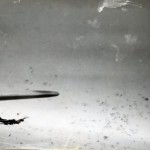 cool
cool 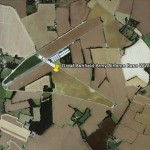 in a crisis. He was a problem solver, who always put his sense of duty before his own desires. He loved his family and his country, and would have died defending any of them, had that been required if him. He was a man to be proud of and the one I am proud to call Daddy. I miss him a lot, but I know I will see him again in Heaven. Today I say, “Thank you Dad, for all you did in your life to make life better for those who were around you, and loved you.”
in a crisis. He was a problem solver, who always put his sense of duty before his own desires. He loved his family and his country, and would have died defending any of them, had that been required if him. He was a man to be proud of and the one I am proud to call Daddy. I miss him a lot, but I know I will see him again in Heaven. Today I say, “Thank you Dad, for all you did in your life to make life better for those who were around you, and loved you.”

